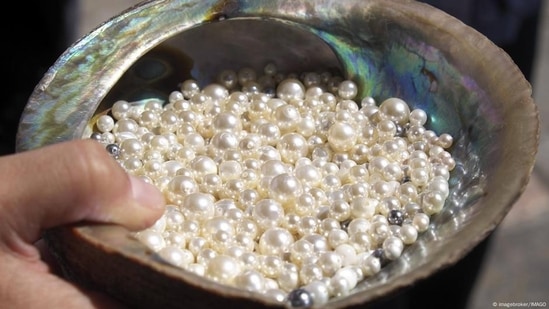
A cultural history of pearls
8 months ago | 108 Views
With the Abernethy pearl expected to fetch a high sum at auction, we look at the history of pearls. Besides its legends and myths, this gem also has a dark side.
One of the largest freshwater pearls ever found in Scottish history will go to auction on August 21 and is expected to fetch between £40,000 and £60,000 (€46,946 to €70,426). It was discovered by pearl diver William Abernethy in 1967 in Scotland's River Tay. Abernethy gained fame as a skilled pearl fisher before the practice was banned in the country in 1998.
While it might seem a high price, the pearl is indeed rare. It is said that only one in every 5,000 mussels found in Scottish rivers has a pearl. The Abernethy pearl was thought to have been growing for 80 years when it was discovered.
Pearls are the only gemstones created by a living creature. They are formed when a hard particle irritates the soft tissue of a mollusk and the mollusk then coats the object with layers of calcium carbonate (or nacre) as a form of self-defense, creating a pearl. Saltwater pearls come from oysters, while freshwater pearls like the Abernethy are found in freshwater mussels.
Although the sale of this pearl known as "Little Willie" is now making headlines, pearls have been in the spotlight throughout history. They've adorned the necks and ears of royalty such as Princess Diana or Queen Elizabeth II, featured as legendary objects in myths and played a dark role as a valuable resource exploited by Spanish colonizers in the New World.
Due to their struggle-related origin, pearls are often seen as symbols of beauty born of adversity. The painter Vincent Van Gogh — well-acquainted with struggle — famously said, "The heart of man is very much like the sea, it has its storms, it has its tides and in its depths, it has its pearls too."
Tears of a goddess
The fact that pearls are formed from living creatures has also added to their mystique. Across many cultures, pearls are seen as symbols of purity, wisdom and divinity. They are often associated with the moon as well as water, due to their aquatic origin.
In Greek mythology, pearls are said to be tears of joy shed by the goddess of love, Aphrodite, who herself was born from sea foam. Aphrodite, or Venus as she is known in Roman mythology, has often been depicted with pearls in works of art over the centuries, such as in the 1751 oil painting "The Toilette of Venus" by French painter François Boucher or the 1907 painting "The Pearls of Aphrodite" by English Neoclassicist painter Herbert James Draper.
In Hindu mythology, the god Krishna is credited with discovering the first pearl. According to legend, he took it from the ocean and gave it to his daughter on her wedding day. Today, pearls still symbolize love, purity and union in Hindu culture.
In other cultures, however, pearls are considered bad luck for weddings. Japanese myth says that pearls were made from the tears of mermaids, bringing sorrow.
In Chinese mythology, pearls are often associated with dragons who are depicted carrying the precious jewels in their mouths or guarding them. The "dragon pearl" symbolizes wisdom, power and luck and is said to represent the harmonious balance of yin and yang, embodying both male and female energies.
A long history
With the advent of pearl farming in Asia in the 19th century, pearls became more affordable. Before that however, pearls were rare and worn primarily by elites to flaunt their wealth and status. The first known mention of pearls is considered to be a mention in the history of Chinese King Shu, which states that in 2206 B.C., King Yu received pearls as a tribute from the Huai River. The oldest known pearl jewelry was found in the sarcophagus of a Persian princess who died in 520 B.C.
Pearls have long been coveted pieces of jewelry and are mentioned in the Old Testament, the Talmud and the Koran. In ancient Rome, pearls were more valuable than diamonds. Julius Caesar even passed a law saying only aristocrats were allowed to wear pearls within the borders of Rome.
Then there's the story of the famous Egyptian queen Cleopatra who, according to "Natural History" written by Roman naturalist and philosopher Pliny the Elder (23 - 79 A.D.), dissolved a pearl in a cup of vinegar and drank it to win a bet against her lover, Marc Anthony. She had bet her beau that she could spend 10 million sesterces (silver coins of ancient Rome) on one meal. "She took one earring off, and dropped the pearl in the vinegar, and when it was wasted away, swallowed it," Pliny the Elder wrote.
Modern scholars have long debated the feasibility of the story, but in 2010, an academic at Montclair State University in New Jersey experimented with vinegar and a five-carat pearl and found out that Cleopatra could have indeed won her bet as described.
Colonial depletion
Like perhaps all gems, pearls also have a sordid history involving abuse and exploitation. They were a prize of the New World when Christopher Columbus reached it and topped the list of what the Spanish Crown sought from the explorer when he returned from his voyages.
The Atlantic coast of Venezuela was rich in pearls and the Spanish colonizers established pearl fishing settlements off the country's coast in the early 16th century as Molly A. Warsh writes in her book, "American Baroque: Pearls and the Nature of the Empire, 1492-1700." Indigenous inhabitants were forced by Spanish colonial troops to dive for pearls.
"The fisheries received early infamy because of a brutal labor system of pearl diving that developed there amid intense debates about policy related to the treatment of the Americas' indigenous inhabitants," Warsh writes.
Tudor England in the 16th century is often referred to as the "Pearl Age" because of the prevalence of the upper classes wearing pearls to show off their wealth and status. One has only to look at portraits painted during the period to see just how frequently the upper classes were draped in pearl jewelery.
The pearl's popularity in Europe during that period led to "an extraordinary assault on the region's marine ecosystem" with many indigenous people abused in the process, Warsh writes.
Yet the history of the pearl marches on, with the sale of the Abernethy pearl as simply its latest chapter.
#




















